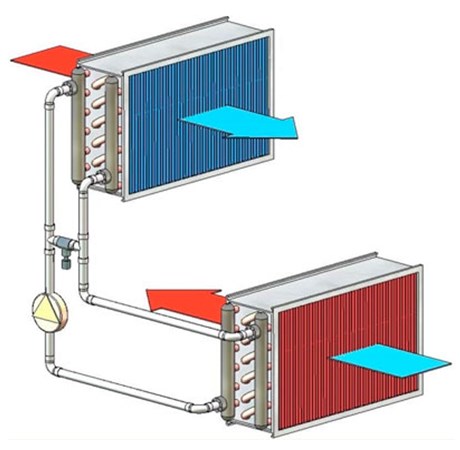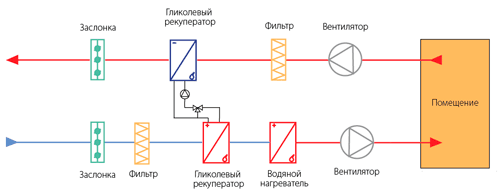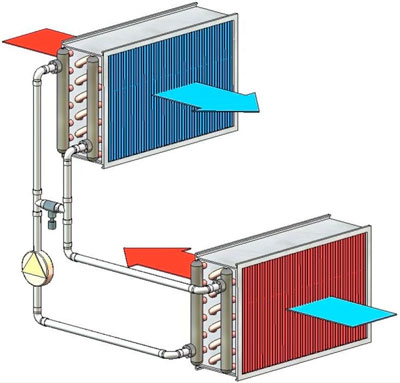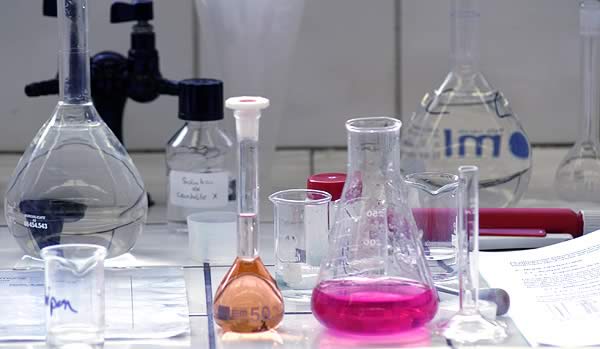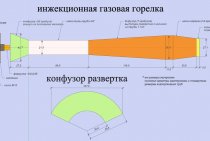Advantages and disadvantages
Despite the rather low thermal efficiency of these devices, they are still quite in demand and are used for installation in functioning ventilation systems with a serious "scatter" in performance.
Moreover:
- Several supply or exhaust air streams can be directed to one heat exchanger.
- The distance between heat exchangers can reach more than 500 m.
- Such a system can be used in winter, as the coolant does not freeze.
- The air streams from the exhaust and supply ducts do not mix.
Among the shortcomings can be noted:
- Sufficiently low energy efficiency (thermal efficiency), which varies from 20 to 50%.
- Serious costs for electricity, which is necessary for the operation of the pump.
- The heat exchanger piping includes a large number of control and measuring devices and shut-off valves, which require periodic maintenance.
These units are designed for the correct operation of air handling units, which include glycol heat exchangers that perform the function of heat recovery.
This mixing unit is installed in the circuit connecting the supply and exhaust glycol heat exchanger by means of a pipeline. The node contains all the necessary strapping elements necessary for the correct operation of the circuit. For the system to function properly, it is sufficient to connect the node to the piping network and connect the drive and pump to the control controller.
During operation, the unit creates the necessary flow rate of the coolant needed to transfer heat from the heated exhaust heat exchanger to the cold supply one. A three-way valve installed in the unit, mixing the glycol flows in the right amount, regulates the maximum performance of the heat exchangers. In the event of subcooling of one of the heat exchangers, a three-way valve mixes a more heated liquid into the circuit, thereby preventing the possibility of freezing of the glycol heater.
The use of a modulating electric drive allows precise control of the three-way valve. Thermomanometers installed in all parts of the unit allow you to monitor the temperature and pressure parameters in different parts of the system. A safety group is installed on the assembly, which contains a safety valve, an air vent and an expansion tank. An air vent is required to automatically bleed air from the system that has entered the circuit during filling.
An expansion tank installed in the glycol circuit is necessary to compensate for excess liquid in the system during a sharp change in temperature in the circuit.
The safety valve should work in the event of an increase in pressure above the set value, thereby protecting other elements from damage. Also included in the circuit of the unit is a drain valve for quickly draining fluid from the system.
Ball valves allow you to block the circuit of the unit and thereby replace its individual elements, if necessary, without draining the entire system.
Mixing units for operation of glycol recuperators are designed to control the flow of ethylene glycol solution in the circuit of recuperation heat exchangers of the supply and exhaust unit.
The task is to provide such a necessary flow rate of the coolant, in such a way as to transfer the heat of the exhaust air to the supply air as much as possible, through a separate closed circuit connecting the supply and exhaust heat exchangers. The coolant of these units is usually a solution of ethylene glycol.
The piping unit for glycol heat exchangers includes the following elements.
- three-way valve;
- electric drive;
- pump;
- sump;
- check valve;
- Ball Valves;
- thermomanometers;
- expansion tank;
- drain tap;
- air vents.
If necessary, the unit is completed with corrugated eyeliners.
These units are used for all air handling units, where the option of heat recovery due to the intermediate heat carrier is provided. As a rule, such units are installed on ventilation systems of medium and high air capacity from 5,000 to 100,000 m 3 h.
If the unit is designed and assembled correctly, then when the system is turned on, the automation of the air handling unit should work in such a way as to ensure first the maximum possible heating of the supply air, using the heat of the glycol circuit, and then connect the heater circuit in order to warm up air to a given temperature.
How a glycol heat exchanger works
The device consists of two finned heat exchangers, which are interconnected in a closed circuit with a coolant (ethylene glycol solution) circulating in it. One heat exchanger is installed in the channel through which the exhaust air passes, the second one is located in the supply air flow. The heat exchangers must operate in counter-current with respect to the air flow. With a direct-flow connection, the efficiency of their work is reduced to 20%.
In the cold season, the first heat exchanger is a cooler, taking heat from the exhaust air flow. The coolant moves through a closed circuit with the help of a circulation pump and enters the second heat exchanger, which acts as a heater, where heat is transferred to the supply air. In the warm period, the functions of heat exchangers are directly opposite.
In winter, condensate may form on the heat exchanger in the exhaust stream, which is collected and discharged using an inclined stainless steel bath with a hydraulic seal. To prevent drops of condensate from entering the exhaust air stream at high flow rates, a drop eliminator is installed behind the heat exchanger.
Where is a glycol heat exchanger used?
The most effective application of glycol heat exchangers is their use in two-circuit schemes. They are indispensable in explosive environments, as well as in cases where air supply and exhaust flows absolutely must not intersect. A similar scheme is actively used in factories with large areas and in shopping centers that maintain different temperature conditions in different areas.
The recuperator with an intermediate heat carrier makes it possible to connect two separately existing ventilation systems - exhaust and supply. Such devices are ideal for upgrading them in case of separate use.
The versatility of glycol recuperators makes it possible to install them in existing systems with a capacity of 500 - 150,000 m3 / h. With their help, you can return up to 55% of the heat. The payback of such systems is from six months to two years. It depends on the region in which the equipment is installed and the intensity of its use. As a rule, an individual calculation of such devices is required.
Operating principle
In this section, a glycol heat exchanger will be discussed in more detail, the principle of operation of which is somewhat similar to that of a conventional air conditioner. In winter, one boiler takes thermal energy from the outgoing air flow of the exhaust vent of the system, and with the help of a water-glycol coolant transfers it to the supply heat exchanger. It is in the second boiler that the antifreeze gives off the accumulated heat to the supply air, heating it. In summer, the action of the heat exchangers of this device is exactly the opposite, therefore, using this type of equipment, you can save not only on heating, but also on air conditioning.
In the cold season, a boiler installed in an exhaust ventilation duct may be exposed to condensate and, as a result, icing. That is why it is equipped with a container with a water seal to collect and drain condensate.In addition, to prevent moisture from entering the air stream, a drop eliminator is usually mounted behind the heat exchanger. To prevent contamination of the supply heat exchanger, a coarse air filter is installed in the ventilation duct.
Installation options
- You can connect several inflows and one exhaust and vice versa.
- The distance between the supply and exhaust can be up to 800 m.
- The recovery system can be adjusted automatically by changing the coolant circulation rate.
- The glycol solution does not freeze, i.e., at sub-zero temperatures, defrosting the system is not necessary.
- Since an intermediate heat carrier is used, air from the hood cannot enter the inflow.
With a two-circuit scheme of a glycol heat exchanger, the amount of exhaust and supply air must match, although deviations of up to 40% are allowed, which worsen the efficiency indicator.
Calculation of the energy efficiency of a device of this type
For efficient operation and maximum heat saving, as a rule, an individual calculation of such equipment is required, which is carried out by specialized companies. You can calculate the thermal efficiency and energy efficiency of such a heat exchanger yourself, using the method for calculating glycol heat exchangers. To calculate the thermal efficiency, it is necessary to know the energy costs for heating or cooling the supply air, which are calculated by the formula:
Q \u003d 0.335 x L x (tend - tbegin),
- L air consumption.
- t start (air inlet temperature in the heat exchanger)
- tcon. (temperature of extract air from the room)
- 0.335 is a coefficient taken from the Climatology handbook for a particular region.
To calculate the energy efficiency of the heat exchanger, use the formula:
where: Q is the energy costs for heating or cooling the air flow, n is the heat exchanger efficiency declared by the manufacturer.
How glycol analysis is performed
The procedure for studying the quality of the coolant is quite simple and does not require much effort from the owner of engineering networks. You take glycol samples and send them to the manufacturer's laboratory for analysis. Specialists carry out the necessary analyzes and determine the quantitative characteristics of the solution. After the research, you receive a full report with recommendations. Based on them, a decision is made. It may be necessary to dispose of the spent ethylene glycol solution and replace the coolant with a new one. Perhaps the deviations from the norm are not so significant and do not affect the efficiency of the climate system.
It is important to note that if the research is carried out by the manufacturer, she perfectly knows all the features of the composition used and can give competent advice. In any case, you get many benefits from such a comprehensive service:
- Certain quantitative characteristics of glycol are compared not with average indicators, but with the initial parameters of this particular solution;
- You can quickly order the replacement of the coolant with the disposal of the waste;
The manufacturer has the necessary material base for the transportation of glycol to the facility and the disposal of the used mixture in accordance with environmental rules and regulations.
Recuperators
In addition, in the conditions of constant rise in energy prices, at present, ventilation units are very often equipped with recuperators of various types and designs, which allow transferring part of the heat from the exhaust air to the supply air.
Cross-flow heat exchangers, due to their design, direct the supply and exhaust air into mutually intersecting channels without mixing and through the surface of thin plate cells, the heat from the exhaust air is transferred to the supply air. The efficiency of such recuperators can reach 75%.
Rotary heat exchangers have a design due to which the heat of the exhaust air is transferred to the supply air by means of a slowly rotating disk, which is a set of many plate-like perforated disks.Rotary heat exchangers allow a small (up to 15%) admixture of exhaust air to supply air. This somewhat narrows the scope of their application, but on the other hand, the efficiency of rotary heat exchangers is much higher than cross-flow heat exchangers - up to 85%, depending on the amount and parameters of the exhaust and supply air.
When the dimensions of the ventilation chamber or other features of the ventilated premises do not allow placing a supply and exhaust unit in one ventilation unit, then a glycol heat exchanger can be used. The glycol heat exchanger works as follows: through two separate heat exchangers on the exhaust and supply flows, the coolant — glycol circulates; The extract air transfers heat through the heat exchanger to the glycol, which in turn heats the plates of the supply heat exchanger. The distance between the exhaust and supply units can be significant and is limited only by the technical capabilities of laying pipelines between the heat exchangers, but the efficiency of the glycol heat exchanger is low, much lower than the cross-flow and, moreover, the rotary heat exchanger.
Currently, many manufacturers have in their range of standard ventilation units of relatively low productivity. These are ventilation units for cottages, offices, small commercial premises, equipped with water, electric heaters, or without them, recuperators of various types. For high performance or some special conditions, ventilation units are selected and manufactured individually, to order. After calculating the ventilation system, indicating all the necessary parameters for selection and design features, the designer issues a technical task for the manufacturer's representative and after a while receives a printout of the installation with the necessary parameters, technical characteristics, dimensions and design. Some manufacturers place equipment selection programs on their websites on the Internet, which allows the designer to create ventilation units of any configuration online.
Key properties of glycol
Before proceeding with the order of research, it is necessary to decide: what properties and characteristics determine the quality of antifreeze with a low freezing point.
- Thermal conductivity;
- Heat transfer coefficient;
- Viscosity;
- Maximum crystallization temperature.
During operation, the coolant can be contaminated with side impurities, which significantly impair the working properties of the fluid. If the concentration of the active substance in the solution does not correspond to the norm, then the freezing point may be much higher than indicated by the manufacturer or required by the operating conditions of the climate system. In some cases, this becomes dangerous, because when using the equipment in harsh climatic conditions, there is a risk of freezing of the liquid in the system. Unlike water, glycol has a low volumetric expansion coefficient, which minimizes the risk of pipeline damage and rupture. But the transition of the solution into a mushy state of aggregation significantly worsens its transportation through the system and causes an increased load on pumping equipment.
A coolant contaminated with impurities has a reduced efficiency, which is expressed in the ability to transfer or remove heat. To ensure the required performance of the system, you need to constantly monitor this and avoid deviations from the norm. The same is true for viscosity. If it exceeds the permissible limits, transportation through the pipeline is possible only with increased power of pumping equipment, which wears out much faster in this mode.
conclusions
It makes sense to use antifreeze for a heating system when there is really a possibility that the water inside the network may freeze
In this case, it is necessary to determine the optimal concentration of the solution for the efficient operation of the entire heating system and take into account the safety requirements
Antifreeze - a coolant based on ethylene or propylene glycol, translated "Antifreeze", from international English, as "non-freezing". Class G12 antifreeze is intended for use on cars from 96 to 2001; modern cars usually use 12+, 12 plus plus or g13 antifreezes.
